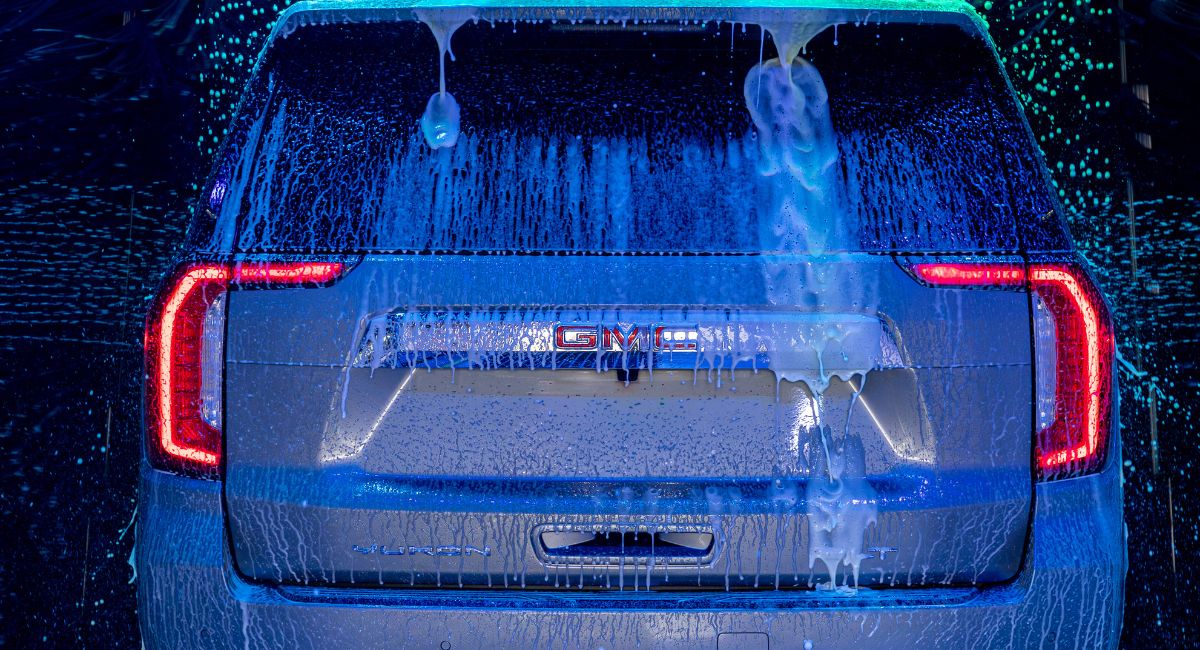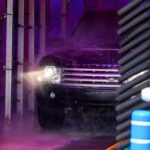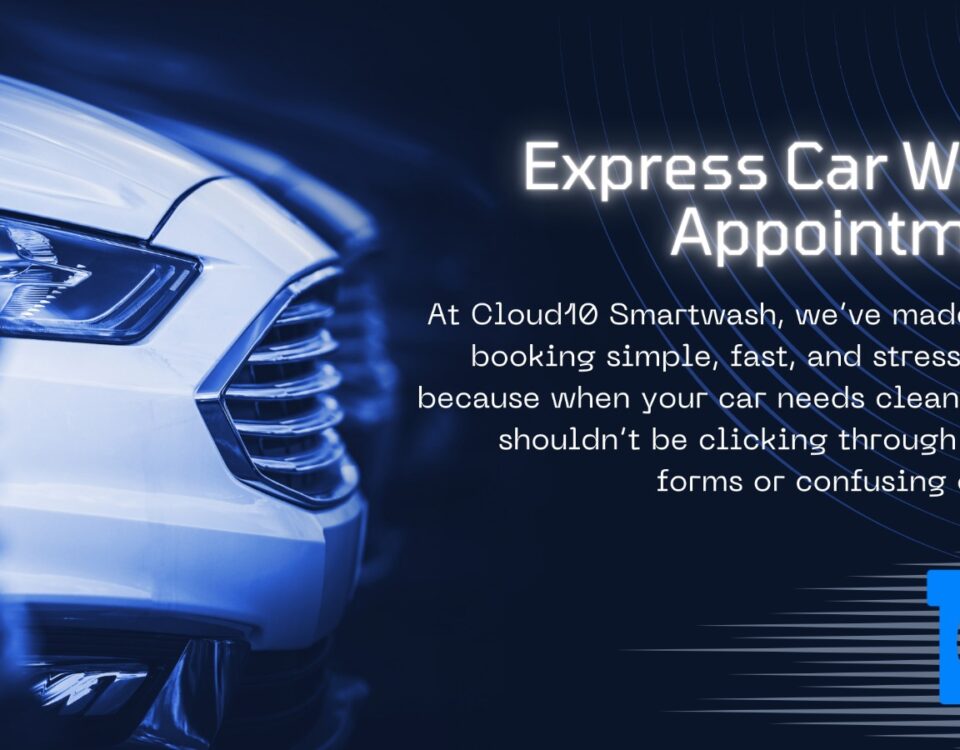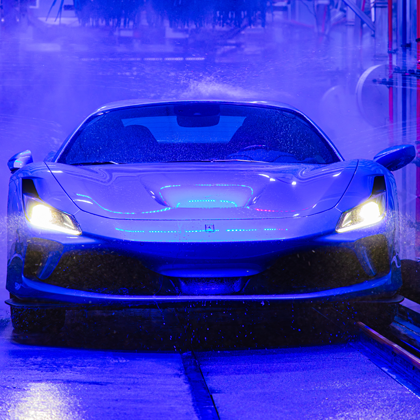
Hey there, car enthusiasts! We all love basking in the sun, but guess what? Our cars don’t.
If you’ve noticed your car’s paint fading, the dashboard cracking, or the headlights getting foggy, that’s sun damage right there. Yup, those UV rays are just as harmful to your vehicle as they are to your skin.
So, let’s dive into understanding sun damage to your car and, more importantly, how to prevent it. Spoiler alert: Cloud10 smartwash has some fantastic solutions for you!
The Science Behind Sun Damage To Your Car
So, what’s the deal with UV rays? Well, ultraviolet (UV) rays are part of the sunlight that hits your car every day. These rays break down the chemical bonds in your car’s paint, causing it to fade over time.
Not just the paint, but the interior materials like plastic, leather, and fabric can also degrade. Heat from the sun speeds up oxidation, making your car’s color dull and lifeless. It’s like your car is getting a sunburn every day, and nobody wants that!
Common Signs of Sun Damage To Your Car
What does sun damage look like? Here are a few telltale signs:
Faded Paint
Your car used to be vibrant and shiny, but now it looks dull and washed out.
Cracked Dashboard and Seats
Those annoying cracks in the dashboard and seats? Blame the sun.
Oxidized Headlights
Your headlights are cloudy and yellow instead of clear.
Damage to Rubber and Plastic Parts
Worn-out wiper blades, cracked window seals, and brittle plastic parts.
The Financial Impact of Sun Damage To Your Car
Here’s a bummer: sun damage can seriously lower your car’s resale value. When your car’s exterior and interior look shabby, potential buyers will either walk away or offer way less than what your car is worth.
A well-maintained car can fetch you a good price, but a sun-damaged one? Not so much.
Repairing sun damage isn’t cheap. Repainting your car can cost a pretty penny, and fixing the interior? Even more.
On average, a professional repaint can set you back between $1,000 to $5,000. Reupholstering the seats and repairing the dashboard can cost hundreds if not thousands.
Regular maintenance and prevention are way more cost-effective in the long run.
Protecting Your Car’s Exterior

First things first, keep your car clean. Regular washing removes contaminants like bird droppings, dirt, and sap that can accelerate sun damage.
But don’t stop there. Waxing your car adds a protective layer that shields the paint from UV rays. Our Hot Wax and Shine – Carnauba Wax at Cloud10 Smartwash is perfect for this. It’s like sunscreen for your car, providing a deep, glossy shine while protecting the paint from the sun.
If you’re a DIY enthusiast, here’s a quick guide to washing and waxing:
Wash Your Car Thoroughly
Use a high-quality car shampoo and a microfiber mitt to clean the surface. Rinse well to remove all soap residues.
Dry Your Car Completely
Use a microfiber towel to avoid water spots.
Apply Wax
Using a foam applicator pad, apply the Hot Wax and Shine – Carnauba Wax in a circular motion. Let it dry to a haze.
Buff the Wax
Use a clean microfiber towel to buff the wax, revealing a shiny, protected surface.
Want to go the extra mile? Use UV-protectant products like Simoniz Graphene. This stuff is game changer in the world of car care, creating a hard, protective layer that resists UV rays, road salt, and other contaminants. It’s like giving your car a superhero shield against sun damage. It’s so powerful and so protective, it’s like placing a barrier that is 200 times tougher than steel over the paint of your vehicle.
Plus, Graphene enhances your vehicle’s shine, making it look brand new and almost wet-like. The blend of Graphene and Ceramic in our Fusion Graphene smartwash provides an extra layer of durability, making the protection last longer than traditional waxes.
Sounds simple, right? Parking in the shade can significantly reduce sun damage. Whether it’s under a tree, in a garage, or using a car cover, keeping your car out of direct sunlight helps maintain its exterior.
It’s a no-brainer but often overlooked. If shade isn’t an option, consider using a high-quality car cover to protect your vehicle when parked outdoors.
Interior Protection Strategies
Window tinting is a game-changer. Not only does it keep your car cooler, but it also blocks up to 99% of harmful UV rays. This means less damage to your dashboard, seats, and other interior parts.
Plus, it gives your car a sleek, stylish look. When choosing window tints, look for options that offer high UV protection and meet legal standards in your area.
Cracking and fading are common issues for dashboards and seats exposed to the sun. Using dashboard and seat covers can protect these surfaces from UV rays.
They’re easy to install and come in various styles to match your car’s interior. Choose covers made from materials that offer UV protection and are designed to withstand high temperatures.
Finally, don’t neglect the inside of your car. Regular cleaning and conditioning can prevent the interior from drying out and cracking.
At Cloud10 smartwash, we recommend using our specially formulated glass cleaner, developed in the CL10 CoLab, in partnership with SIMONIZ, for your windows and interiors.It keeps everything looking fresh and new. Here’s a quick guide for interior maintenance:
Condition Leather and Plastics:
Apply a conditioner to prevent drying and cracking.
Use Sunshades:
Place sunshades on your windshield when parked to reduce direct sunlight exposure.
Innovative Solutions for Sun Damage Prevention
Ceramic coatings are all the rage, and for a good reason. They offer long-term protection against sun damage.
Our Simoniz Ceramic Sealant at Cloud10 smartwash creates a strong, hydrophobic layer that bonds to your car’s surface. This layer resists water, stains, and UV rays, providing a deep, reflective shine.
It’s like giving your car an armor suit. The ceramic polymer chemically bonds with your car’s paint, offering superior protection that lasts up to two years with proper maintenance.
Protective films are another great option. These clear films are applied to your car’s paint to protect it from scratches, chips, and UV damage.
They’re virtually invisible and can significantly extend the life of your car’s paint. It’s a bit of an investment but worth it if you’re serious about protecting your car.
Protective films are especially beneficial for high-impact areas like the front bumper, hood, and side mirrors.
DIY vs Professional Help
Doing it yourself can save money, but it comes with risks. DIY products may not offer the same level of protection as professional-grade ones.
Plus, improper application can lead to streaks, bubbles, or even damage to your car’s paint. If you’re confident in your skills, go for it. But remember, you get what you pay for.
DIY methods can be time-consuming and require some level of expertise. For instance, applying a ceramic coating yourself might seem cost-effective, but it requires precise preparation and application to ensure it bonds correctly with the paint. If done incorrectly, it can result in an uneven finish or even damage the paint.
When you opt for a professional and automatic option, like Cloud10 smartwash, we will guarantee precise and professional application of these products that enhance the protection and cleanliness of your vehicle. But what’s more, you’ll actually save time and money when you visit us.
Whether it’s waxing, ceramic coating, or UV protection, we’ve got you covered. Plus, you save time and avoid the hassle of doing it yourself.
At Cloud10 Smartwash, we provide a comprehensive service that includes:
● thorough cleaning,
● expert application of protective products,
● and personalized advice on maintaining your car’s condition.
Our state of the art smart tunnel is programmed to handle all types of vehicles and ensure that the products are applied evenly and effectively.
Myths About Sun Damage and Car Care
Let’s bust some myths:
“Red cars fade faster”:
All colors fade over time, but red is more noticeable. Regular maintenance can keep any color looking vibrant. It’s not the color itself but the type of pigment used in the paint that affects how quickly it fades.
“Waxing too often is bad for your car”:
Not true! Regular waxing protects your car’s paint and can be done as often as needed, especially if you use high-quality waxes like our Hot Wax and Shine – Carnauba Wax.
Frequent waxing helps to maintain a protective layer that shields the paint from UV rays and other environmental factors.
“My car is fine as long as it’s parked in the shade”:
While shade helps, it’s not foolproof. UV rays can still reach your car indirectly, so additional protection is necessary. Dust and moisture can still settle on your car, causing damage over time if not properly cleaned and protected.
Sun Damage to Your Car Is Preventable
To sum it all up, sun damage to your car is a real problem, but it’s preventable. Regular washing and waxing, using UV protectant products, parking in the shade, and protecting the interior can keep your car looking great for years.
At Cloud10 smartwash, we offer a range of services and products designed to protect your car from sun damage. From Hot Wax and Shine – Carnauba Wax to Simoniz Graphene and Simoniz Ceramic Sealants, we’ve got everything you need to keep your car in top shape.
By investing in these protective measures now, you’ll save money on repairs and maintain your car’s value.
Plus, you’ll enjoy a shiny, well-maintained vehicle that looks great and performs better. Don’t let the sun take a toll on your prized possession. Take action today!
Visit us at Cloud10 Smartwash for professional and innovative smartwash. We’ll help you keep your car looking new and shielded from the harsh effects of the sun, and you’ll never want to go to a regular car wash again.
Visit our website or stop by a location today! Your car will thank you.
FAQs
1. How often should I wax my car to protect it from sun damage?
Regular waxing every 3-4 months is recommended to maintain a protective barrier on your car’s paint. Our Hot Wax and Shine – Carnauba Wax enhances shine and shields against UV rays and environmental contaminants, prolonging the life of your car’s exterior.
2. Is ceramic coating better than traditional wax for sun protection?
Yes, ceramic coatings like our Simoniz Ceramic Sealant offer superior UV protection and durability compared to traditional wax. These coatings create a resilient, hydrophobic layer that bonds chemically with the paint, providing long-lasting defense against UV rays, dirt, and pollutants.
3. Can window tinting really prevent sun damage to my car’s interior?
Absolutely! High-quality window tint films effectively block UV rays, significantly reducing heat buildup inside your car and protecting its interior from fading, cracking, and discoloration. At Cloud 10 Smartwash, we recommend tint options that offer maximum UV protection to maintain your car’s interior aesthetics.
4. What are the signs that my car is experiencing sun damage?
Signs of sun damage include noticeably faded paint, especially on dark or vibrant colors, as well as cracks on the dashboard and seats. Oxidized headlights and brittle rubber or plastic parts are also indicators. Regularly inspecting your car for these signs helps you address issues promptly and prevent further deterioration.
5. How does parking in the shade help prevent sun damage?
Parking in shaded areas significantly reduces direct exposure to UV rays, which is crucial for minimizing paint fading and interior damage. By shielding your car from prolonged sunlight, you can preserve its appearance and structural integrity over time, contributing to its longevity and resale value.








